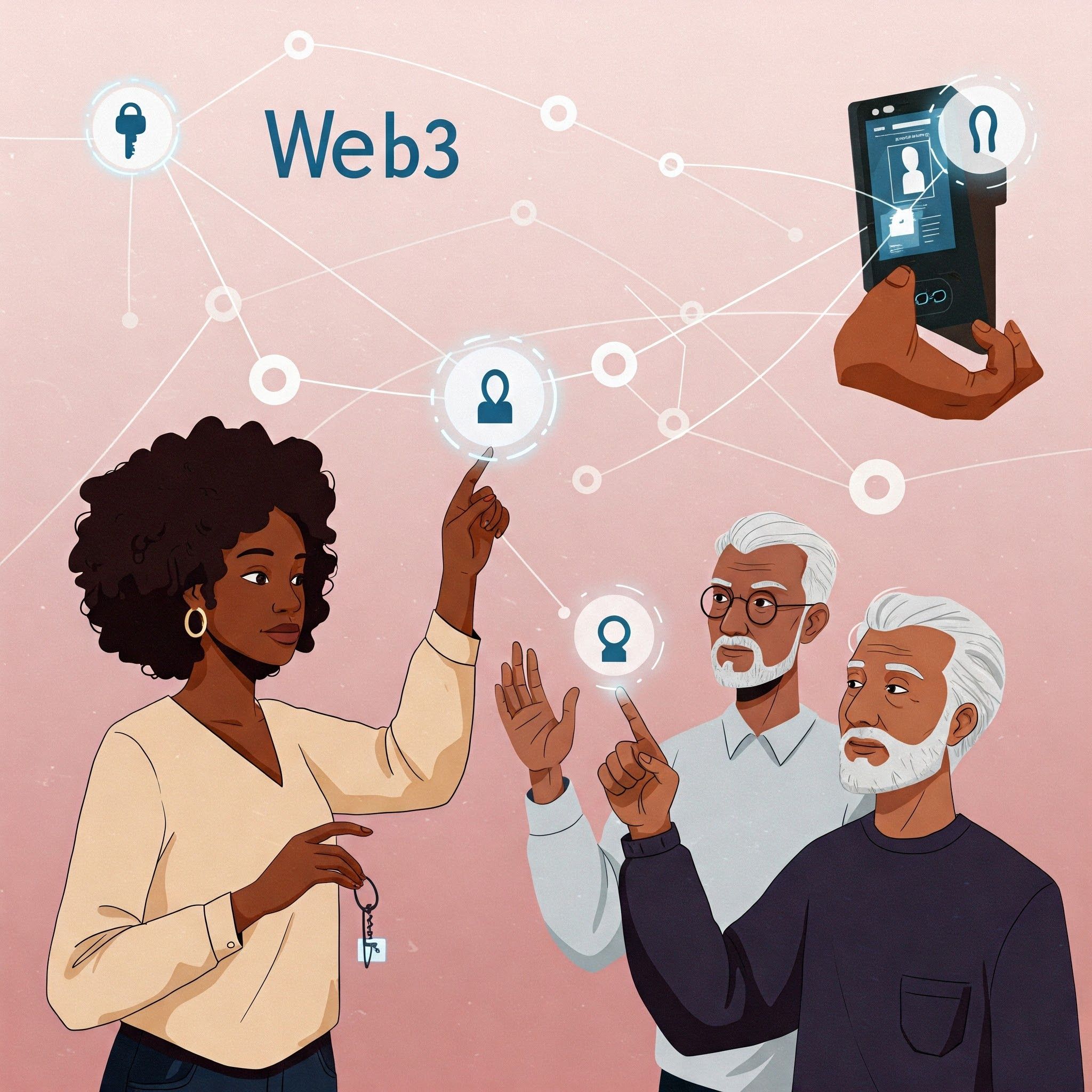Web3 and Digital Identity: Building A Decentralized ID Management System

Prasad Kumkar
CEO

The Crisis of Centralized Identity Systems#
Centralized identity management (CIM) has dominated the digital landscape for decades, but its flaws are increasingly exposed. Under this model, institutions like governments, tech giants, and banks act as gatekeepers, storing sensitive user data on vulnerable servers.
Key Failures of Centralized Systems:#
- Single Points of Failure: Breaches at centralized authorities compromise millions (e.g., 3 billion Yahoo accounts hacked in 2013–2014)4.
- Data Exploitation: Companies monetize user data without consent, creating privacy risks3.
- Fragmented Identities: Users manage 100+ accounts on average, increasing vulnerability to phishing3.
- Exclusion: 1 billion people lack government-issued IDs, locking them out of essential services4.
Web3’s decentralized identity management (DIM) addresses these issues by shifting control to users via blockchain, cryptography, and self-sovereign identity (SSI) frameworks.
How Web3 Reimagines Digital Identity#
Web3 introduces a decentralized approach to identity management, empowering individuals with control over their digital identities through technologies like blockchain and self-sovereign identity (SSI) frameworks.
Core Components of a Decentralized Identity System#
- Decentralized Identifiers (DIDs):
- Unique, user-owned identifiers stored on blockchain (e.g., Ethereum, Polygon)1.
- Eliminate reliance on centralized registries (e.g., Google/Facebook logins).
- Verifiable Credentials (VCs):
- Tamper-proof digital proofs (e.g., diplomas, licenses) issued by trusted entities.
- Stored in user-controlled wallets and shared selectively via zero-knowledge proofs (ZKPs).
- Blockchain Anchors:
- Immutable record of credential issuance/revocation, ensuring auditability without exposing raw data5.
- Universal Protocols:
- Standards like W3C’s DID and VC specifications ensure interoperability across platforms5.
Web3 Authentication: A Passwordless Future#
Traditional authentication mechanisms relying on usernames and passwords are increasingly being supplanted by more secure and user-friendly Web3 authentication models:
Web3 Authentication Models and How It Works
- Wallet-Based Login: Users authenticate by signing transactions through crypto wallets (e.g., MetaMask, Coinbase), eliminating the need for passwords and reducing phishing risks.
- DID-Auth: Decentralized identifiers facilitate the verification of identity claims without intermediaries, enhancing privacy and control.
- Biometric Zero-Knowledge Proofs (ZKPs): Biometric data (e.g., facial or fingerprint scans) can be verified using ZKPs, allowing authentication without revealing the actual biometric information, thereby preserving privacy.
Benefits vs. Web2 Auth:
- No Passwords: 81% of breaches exploit stolen credentials2.
- Reduced Friction: One-click logins via wallets improve UX.
- Anti-Phishing: Cryptographic signatures prevent impersonation2.
Strategic Advantages for Businesses#
1. Enhanced Security & Compliance#
- GDPR/CCPA Alignment: Users consent to data sharing, minimizing legal risks5.
- Breach Resistance: Decentralized storage mitigates the risks associated with centralized data breaches, enhancing overall security.4.
2. New Revenue Streams#
- Tokenized Loyalty Programs: Businesses can create token-based reward systems, offering customers transferable tokens that can be used within a broader ecosystem, enhancing engagement and loyalty.
- Micro-Credentialing: Sell skill certifications as NFTs (e.g., Coursera x blockchain).
3. Operational Efficiency#
- Automated KYC/AML: Decentralized identity systems streamline Know Your Customer (KYC) and Anti-Money Laundering (AML) processes, reducing verification times and operational costs.5.
- Cross-Border Compliance: Portable DIDs simplify global user onboarding.
4. Trust-Building#
- Transparent data practices increase customer retention (72% of users prioritize privacy3).
Implementation Roadmap#
Phase 1: Assessment#
- Audit Existing Systems: Identify vulnerabilities and inefficiencies in current identity management frameworks.
- Identify Use Cases: Determine areas where decentralized identity can add significant value, such as customer onboarding or secure access control.
Phase 2: Platform Selection#
Assess platforms like Ethereum (suitable for decentralized finance and autonomous organizations), Polygon (offering scalability for enterprise applications), or Hedera (known for regulatory compliance features), considering trade-offs like transaction costs and network governance.
Phase 3: Integration#
Transitioning to a decentralized identity framework necessitates meticulous integration strategies to ensure seamless operation alongside existing systems.
- Hybrid Approach: Maintain Web2 auth while rolling out Web3 options.
- Wallet Integration: Support MetaMask, Coinbase, and email-based wallets.
Phase 4: User Education#
Educating users is crucial for the successful adoption of decentralized identity systems.
- Tutorials and Guides: Develop comprehensive resources to assist users in setting up and managing their digital wallets, emphasizing security practices like backup procedures.
- Incentivization: Offer rewards, such as exclusive Non-Fungible Tokens (NFTs) or other digital assets, to encourage users to engage with the new system.
Challenges & Mitigations#
Adopting decentralized identity systems presents unique challenges that require strategic solutions.
- User Adoption:
- Solution: Abstract blockchain complexity (e.g., ENS usernames instead of wallet addresses).
- Interoperability:
- Solution: Adopt W3C standards and cross-chain protocols like IOTA’s Tangle.
- Regulatory Uncertainty:
- Solution: Work with legal experts to design GDPR-compliant ZKP systems.
Future Trends Shaping 2025+#
The landscape of digital identity is continually evolving, with emerging trends poised to influence its trajectory.
- AI-Powered Identity Oracles: Artificial Intelligence (AI) can enhance the verification of credentials without compromising personal data, streamlining authentication processes.
- Sybil-Resistant Systems: Implementing protocols that verify the uniqueness of users can prevent fraudulent activities, particularly in decentralized networks.
- Decentralized Reputation Scores: Developing trust metrics based on on-chain activities can facilitate more reliable peer-to-peer interactions.
Chainscore Labs: Your Web3 Identity Partner#
Navigating decentralized identity requires specialized expertise. Chainscore Labs (chainscore.finance) offers end-to-end solutions:
- Custom DID Frameworks: Design SSI systems tailored to your industry.
- Smart Contract Audits: Ensure compliance and security for credential issuers.
- Wallet Integration SDKs: Simplify user onboarding across platforms.
- Regulatory Guidance: Align with evolving global standards.
Conclusion: The Imperative of Decentralized Identity#
Web3 identity isn’t a distant future—it’s a present-day necessity. Businesses that adopt DIM now will gain:
- Unmatched Security: Eliminate centralized breach risks.
- User Loyalty: Build trust through transparent data practices.
- Market Agility: Lead in industries like finance, healthcare, and IoT.
The transition requires strategic planning, but the ROI in risk reduction, efficiency, and innovation justifies the investment.
Ready to future-proof your identity management?
Explore Chainscore Labs’ Web3 Solutions Today →
Citations:
- https://www.infuy.com/blog/an-overview-of-web3-identity-in-2023-the-future-of-decentralized-identity-and-its-implications/
- https://www.miniorange.com/blog/web3-authentication/
- https://zircon.tech/blog/the-challenges-of-digital-identity-in-the-modern-world/
- https://fastercapital.com/topics/challenges-of-centralized-identity-systems.html
- https://www.identity.com/digital-identity-why-it-matters-in-web3/
- https://blog.quicknode.com/web3-and-blockchain-identity-solutions-for-more-protected-convenient-digital-identities/
- https://www.okta.com/blog/2021/01/what-is-decentralized-identity/
- https://www.encora.com/insights/decentralized-identity-principles-applications-and-benefits
- https://www.oneidentity.com/learn/what-is-a-decentralized-identity.aspx
- https://blockapps.net/blog/the-foundation-of-digital-identity-in-web3/
- https://101blockchains.com/decentralized-identity-challenges-solutions/
- https://www.identity.com/web3-tools-and-trends-shaping-identity/
- https://cointelegraph.com/learn/what-is-web-3-0-a-beginners-guide-to-the-decentralized-internet-of-the-future
- https://www.techtarget.com/searchsecurity/tip/Top-3-Web3-security-and-business-risks
- https://www.mdpi.com/2813-5288/1/2/8
- https://www.coindesk.com/opinion/2022/12/28/how-web3-helps-people-take-control-of-their-digital-identity
- https://aws.amazon.com/what-is/web3/
- https://www.techtarget.com/searchsecurity/answer/What-are-some-of-the-top-identity-and-access-management-risks
- https://www.globalsign.com/en/blog/sg/digital-identity-management-how-its-revolutionizing-user-and-device-authentication
- https://www.strongdm.com/blog/centralized-decentralized-identity-management
- https://arxiv.org/html/2402.04897v1
- https://www.bain.com/insights/web3-could-rewrite-user-identity-rules-tech-report-2022/
- https://www.techtarget.com/searchsecurity/post/Web3-blockchain-enables-users-to-take-control-of-identity
- https://www.jpmorgan.com/onyx/documents/Digital-identity-assessing-web3s-building-blocks.pdf
- https://www.kucoin.com/learn/web3/five-best-decentralized-identity-did-projects
- https://www.securitymagazine.com/articles/100742-will-decentralized-identity-unlock-the-future-of-identity-protection
- https://www.jpmorgan.com/onyx/digital-identity-web3-building-blocks.htm
- https://pmc.ncbi.nlm.nih.gov/articles/PMC9907408/
- https://auth0.com/blog/identity-and-web3/
- https://www.linkedin.com/pulse/web3-digital-identity-navigating-future-personal-data-hendricks-qxedf
- https://www.socialmediaexaminer.com/digital-identity-why-it-matters-in-web3/
- https://pmc.ncbi.nlm.nih.gov/articles/PMC7013398/
- https://www.securitymagazine.com/articles/83740-four-risks-in-manual-identity-enrollment
- https://alicebiometrics.com/en/challenges-of-digital-identity/
- https://privacyinternational.org/explainer/2672/understanding-identity-systems-part-3-risks-id
- https://fingerprint.com/blog/digital-identity-management/
- https://www.identity.com/centralized-vs-decentralized-identity-management/
- https://www.ccn.com/7-key-benefits-of-web3/
- https://www.identity.com/web3/
- https://www.linkedin.com/pulse/web3-future-digital-identity-empowering-users-connected-world
- https://www.biometricupdate.com/202409/owning-your-identity-in-the-web3-age-the-shift-to-decentralized-security
- https://moralis.io/web3-wiki/top/decentralized-identity-tools/
- https://www.alchemy.com/best/web3-authentication-tools
- https://akava.io/blog/decentralized-identity-in-web3-applications

About Prasad Kumkar
CEO
Prasad Kumkar, a technology leader, founded Chainscore Labs to lead the Web3 revolution. With over 6+ years of experience, he excels at building and scaling engineering projects. As the Head of Web3 at Ignite Tournaments, he grew the team, leading to significant contributions in its growth, serving millions. He has a proven history of turning innovative ideas into successful products, as demonstrated by his role at Reax Finance, Tekika, and Telosx.
